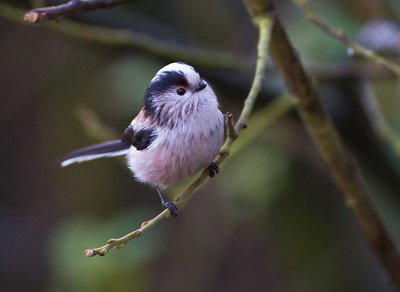 The Long-tailed Tit lives up to its name, with a tail that is longer than its body.
The Long-tailed Tit lives up to its name, with a tail that is longer than its body.
Photo: Ray Surridge
Scientific name: Aegithalos caudatus
Other common names: Long-tailed Bushtit
Conservation status: Not a species of concern in the UK, Europe or globally.
 Often spotted in small flocks of up to 20 birds or so, the gregarious Long-tailed Tit is easily recognisable despite its small size (a total of about 14 cm in length, including the tail), with a tail longer than its body, black and white upper parts, white throat and pinkish breast, and the bold black eye stripe crossing its white crown. It can be seen (and heard – this is a noisy bird) flitting between trees and bushes in woodlands, woodland edges and hedgerows, and even on heaths where there are enough shrubs, making its ‘tsee-tsee-tsee’ contact call. In the winter, they will often join mixed groups of Tit species.
Often spotted in small flocks of up to 20 birds or so, the gregarious Long-tailed Tit is easily recognisable despite its small size (a total of about 14 cm in length, including the tail), with a tail longer than its body, black and white upper parts, white throat and pinkish breast, and the bold black eye stripe crossing its white crown. It can be seen (and heard – this is a noisy bird) flitting between trees and bushes in woodlands, woodland edges and hedgerows, and even on heaths where there are enough shrubs, making its ‘tsee-tsee-tsee’ contact call. In the winter, they will often join mixed groups of Tit species.
 Long-tailed Tits are distributed across the UK, although they are absent from the extreme north and west of Scotland, and are found across Europe and Asia. Predominantly insectivorous, they will also eat berries in the winter when food is scarcer. Their nests, which are built in a tree or shrub, are a marvel of creation: the bird weaves spider webs into the sphere of lichen, feathers and moss, meaning that the construction can expand with the growing chicks. One clutch is laid per year, between late March and April, comprising six to twelve red-flecked white eggs.
Long-tailed Tits are distributed across the UK, although they are absent from the extreme north and west of Scotland, and are found across Europe and Asia. Predominantly insectivorous, they will also eat berries in the winter when food is scarcer. Their nests, which are built in a tree or shrub, are a marvel of creation: the bird weaves spider webs into the sphere of lichen, feathers and moss, meaning that the construction can expand with the growing chicks. One clutch is laid per year, between late March and April, comprising six to twelve red-flecked white eggs.
Did you know…?
…There is a northern subspecies which has an all-white crown, with no black eye stripe.
…If a pair’s nest fails, then they will often help feed the young of relatives.
More information and references:
Gooders, J. and Harris, A., 1986. Field Guide to the Birds of Britain and Ireland. Kingfisher Books, London.
Published: December 2013 (updated October 2014)
Author: Amanda Scott
Photos: Upper – Ray Surridge; lower – © Allan Drewitt/NE
